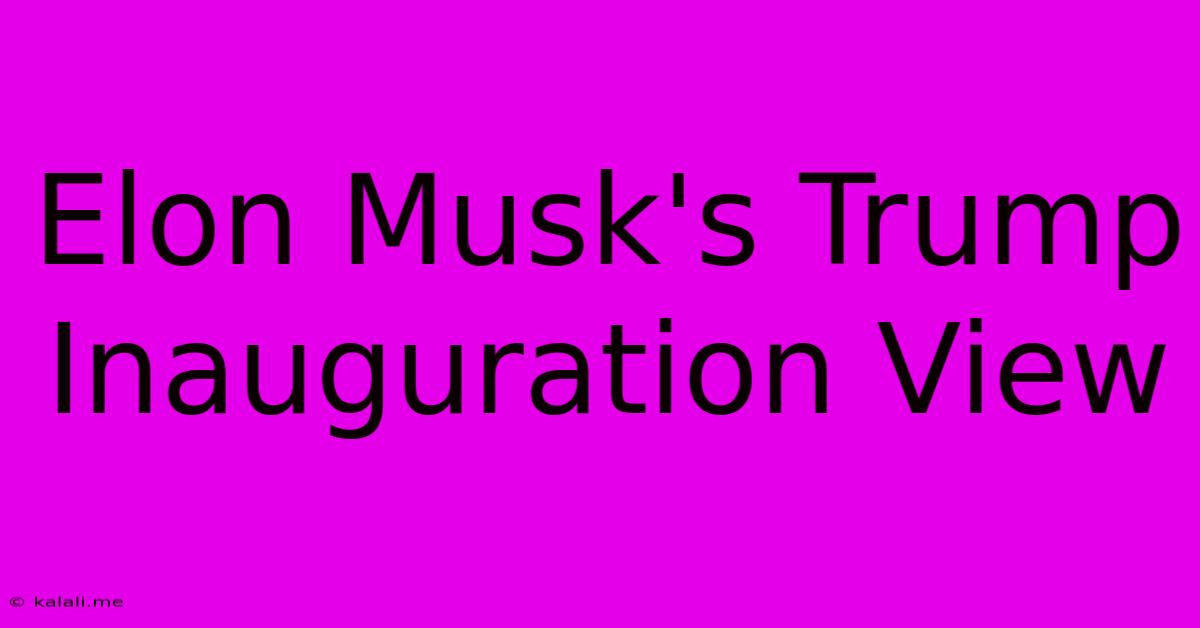Elon Musk's Trump Inauguration View
Kalali
Jan 24, 2025 · 4 min read

Table of Contents
Elon Musk's Trump Inauguration View: A Complex Relationship Unfolds
Elon Musk, the visionary entrepreneur behind SpaceX and Tesla, has never shied away from controversy. His public pronouncements, often delivered via Twitter, have frequently sparked debate and ignited social media firestorms. One particularly intriguing aspect of his public persona is his relationship with former President Donald Trump, particularly in light of the events surrounding the 2017 inauguration. Understanding Musk's perspective on this pivotal moment requires examining his evolving relationship with Trump, his business interests, and his broader political leanings.
The Pre-Inauguration Landscape: A Cautious Optimism?
Before the inauguration, Musk's stance towards Trump was a blend of cautious optimism and pragmatic business calculation. While he publicly expressed concerns about certain aspects of Trump's campaign rhetoric, particularly regarding climate change and international relations, he also saw potential for collaboration on issues critical to his companies' success.
Space Exploration and Infrastructure: Shared Goals?
Trump's focus on infrastructure development and a renewed emphasis on space exploration resonated with Musk's ambitious goals for SpaceX. The prospect of increased government funding for space programs and a more streamlined regulatory environment for private space ventures offered tangible benefits. This potential for mutual gain likely influenced Musk's initial approach to the incoming administration.
The Business Acumen Angle: Navigating Political Uncertainty
Musk, known for his pragmatic approach to business, likely recognized the importance of maintaining a constructive dialogue with the new administration, regardless of his personal political leanings. Navigating the complex political landscape of Washington D.C. required engagement, even if that engagement involved a figure as controversial as Donald Trump.
The Inauguration Itself: A Silent Observer or Active Participant?
While Musk's public statements surrounding the inauguration itself were relatively muted, his actions and subsequent pronouncements suggest a complex internal calculus. He didn't participate in any high-profile events or offer effusive endorsements. This could be interpreted in several ways:
Maintaining Distance While Exploring Opportunities
His silence could be interpreted as a strategic move to maintain a degree of distance while simultaneously exploring potential avenues for collaboration. Openly embracing Trump could have alienated a significant portion of his customer base and investor community, especially those with progressive political views.
A Pragmatic Approach to Political Engagement
Musk's approach often prioritizes practical outcomes over symbolic gestures. Focusing on securing beneficial policies for his companies might have taken precedence over publicly aligning himself with a highly divisive figure.
Assessing the Political Climate: A Wait-and-See Approach
The early days of the Trump administration were characterized by significant uncertainty. Musk may have chosen to wait and see how the administration's policies would unfold before committing to a particular stance.
Post-Inauguration Developments: A Shifting Dynamic
The years following the inauguration witnessed a noticeable evolution in Musk's relationship with Trump. While periods of apparent collaboration existed, growing disagreements and diverging viewpoints became increasingly prominent.
Policy Disagreements and Public Divergences
Issues such as climate change policy, environmental regulations, and the handling of the COVID-19 pandemic created significant friction between Musk and the Trump administration. Public disagreements on these critical issues highlighted a growing ideological divide.
Twitter's Role in Shaping Public Perception
Musk's frequent use of Twitter further complicated the narrative. His tweets, often impulsive and provocative, frequently clashed with the prevailing political climate, blurring the lines between personal opinion and calculated strategy. This made it difficult to decipher his true feelings towards the Trump administration and its policies.
Analyzing the Long-Term Impact: A Lesson in Strategic Engagement
Musk's approach to the Trump inauguration and subsequent interactions offers a fascinating case study in navigating the complexities of political engagement for business leaders. His strategy, though seemingly inconsistent at times, ultimately reflects a pragmatic prioritization of his companies’ interests.
The Importance of Calculated Risk
Musk's actions demonstrate the inherent risks involved in aligning too closely with any particular political figure. His calculated distance from overt endorsement, while exploring potential avenues for collaboration, showcases a careful balancing act.
The Power of Strategic Ambiguity
Musk’s ability to maintain a degree of strategic ambiguity, avoiding definitive pronouncements while pursuing his business goals, is a hallmark of his leadership style. This ambiguity allows him to adapt to changing political landscapes and maintain a broader base of support.
Lessons for Future Leaders
For aspiring entrepreneurs and business leaders, Musk's experience offers several valuable lessons: Maintain open communication, but avoid becoming overly reliant on any single political administration. Prioritize long-term strategic goals over short-term political gains. Cultivate a resilient brand image capable of weathering political storms.
Conclusion: Beyond the Inauguration
Elon Musk's perspective on the Trump inauguration is not simply a historical footnote; it's a microcosm of his broader approach to navigating the intersection of business and politics. His actions highlight the complexities of balancing corporate interests with personal political leanings in a highly polarized environment. By examining his choices, we gain insights into the strategies employed by successful entrepreneurs and the ongoing challenges of operating in an increasingly unpredictable political climate. The relationship between Musk and the Trump administration serves as a compelling example of the delicate balance between pragmatic collaboration and the maintenance of an independent brand identity. The continuing evolution of this dynamic suggests that the story is far from over.
Latest Posts
Latest Posts
-
Words To Somewhere Over The Rainbow Judy Garland
Jul 06, 2025
-
How Old Am I If Born In 1986
Jul 06, 2025
-
Where Is Food Coloring In The Grocery Store
Jul 06, 2025
-
How Do You Say Pickles In Spanish
Jul 06, 2025
-
How Much Is 1000 Hours In Days
Jul 06, 2025
Related Post
Thank you for visiting our website which covers about Elon Musk's Trump Inauguration View . We hope the information provided has been useful to you. Feel free to contact us if you have any questions or need further assistance. See you next time and don't miss to bookmark.